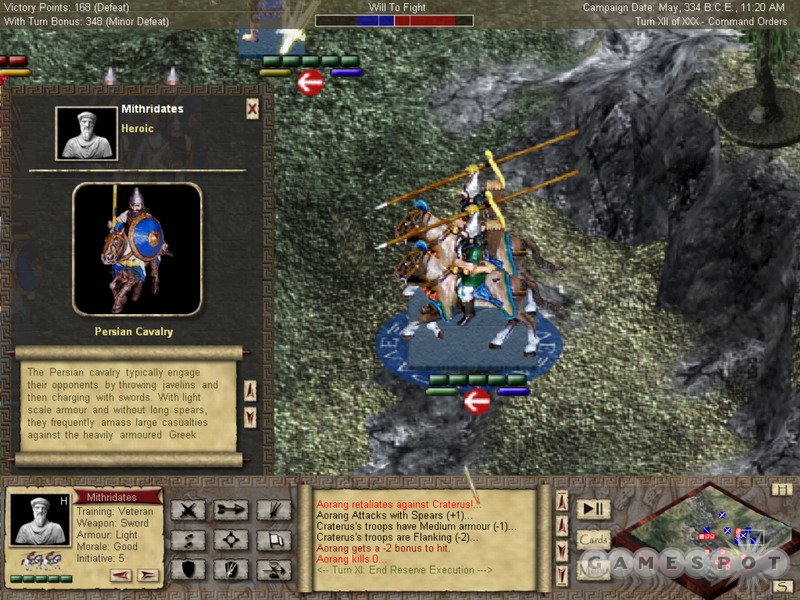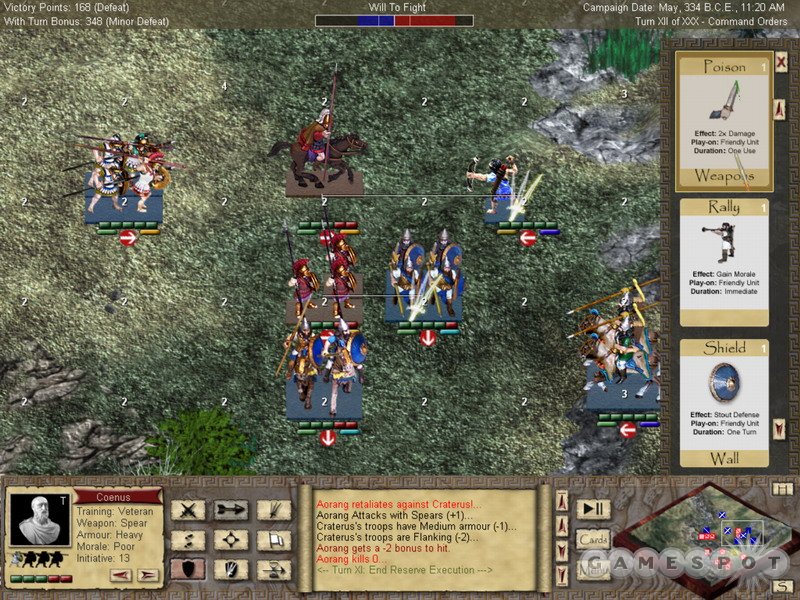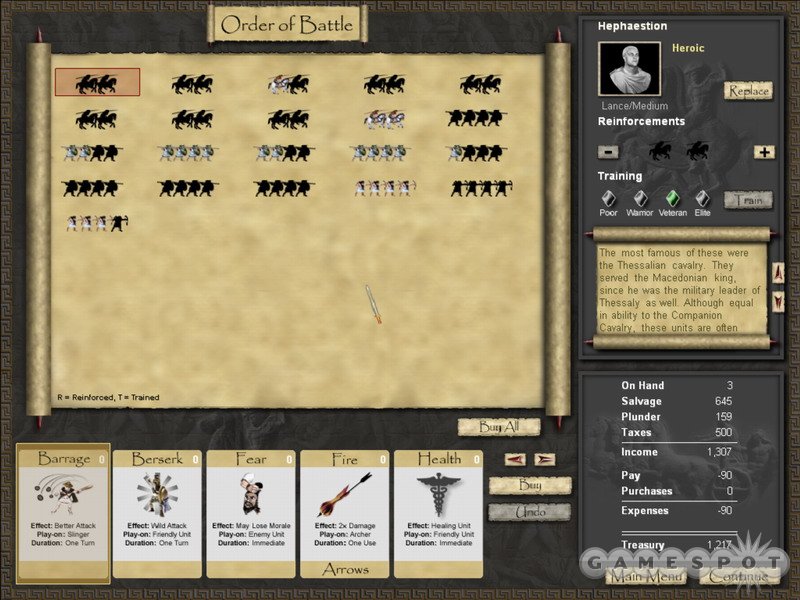Many PC wargames are based on board games, but Tin Soldiers: Alexander the Great is the computer implementation of a miniatures system, covering most of the major engagements Alexander the Great participated in as he conquered his way from Greece to India.

There are plenty of hardcore PC and console game players around, but miniatures players tend to take their hobby to entirely new extremes of fanaticism. Putting together a respectable-sized army of minis costs anywhere from hundreds to thousands of dollars, and in most cases hundreds to thousands of hours are then spent meticulously painting each and every figure. More painstaking work (and another boatload of cash) goes into creating terrain to fight on. When you finally get down to playing, you have to deal with reams of bookkeeping, rules arbitration, and carefully moving units around the map and taking constant measurements. It's more a lifestyle than a pastime, and Tin Soldiers: Alexander the Great gives the rest of us a relatively inexpensive glimpse into this type of gaming without having to deal with all of the drawbacks.
This game doesn't just have a miniatures theme--it's basically a carbon copy of a real miniatures game ported to the PC. Unit graphics, while not 3D, are digital images of real hand-painted miniatures. Even the trees on the maps have round bases like those you'd purchase at the hobby store, and the game takes this theme so far that a virtual hand descends from the top of the screen to grab units off the map when they've taken casualties. There are no unit animations during movement or combat, with units simply sliding from place to place, but the sound effects and especially the soundtrack are excellent for a game of this type. It's too bad the cutscenes that set the stage before each battle are of such low quality, and it would be great if the unit graphics had higher resolution, but overall the game is a joy both to look at and to play.
Only eight battles are included with the game, but some are very large. Starting with Alexander's crushing of the rebellion in Thebes, play then progresses to the Granicus River, Alexander's first encounter with the Persian King Darius III at Issus, and his attack on Gaza as he marched to Egypt. After that, you can relive the battle of Gaugamela and fight against King Porus at the Hydaspes River in India. Two special multiplayer-only scenarios are included, covering the battle in Bactria and a final, obviously hypothetical fight that takes place in Alexander's afterlife on the Fields of Elysium. In the single-player game these battles must be fought in order during the campaign game, but two players are free to try any of them right off the bat in multiplayer mode.
Arguments can be made that many of the battles modeled in the game are not accurate re-creations of the historical realities, but that problem is inherent to any miniatures system. Designers must decide where to draw the line between abstraction and simulation, and in this case it's just about perfect for the subject matter. Even when the particulars of a battle aren't modeled well, the key elements that defined it remain intact, which makes for a much more compelling and balanced game than a strict simulation would be.

The bulk of the fighting in each battle is done by light, medium, and heavy cavalry and infantry. Archers and slingers are also incorporated, but they weren't used in significant numbers in most of the battles fought during this period. All combat is subject to a long list of modifiers, including the type of armor the unit wears, the unit's morale status, the skills its leader has, the weapon it uses, the type of attack or defense it is ordered to carry out, and so on. When plotting potential moves, all of the modifiers involved are computed, and the final tally is displayed on the screen, giving an instantaneous calculation of the odds for every attack. If you see +6/-2, for example, that means your unit will have six added to its base attack roll, while the enemy unit will have two subtracted from its base defense roll. This makes it easy to learn the game while playing it, although some understanding of the roles the different units play helps immensely when setting up for attacks or figuring out what defensive stance to take.
Unit experience is handled well and is extremely important. We learned this the hard way after purchasing some archer and slinger units with minimal training before one battle and then watching in horror as they ended up doing more damage to their own allies than they did to the enemy. Putting them a safe distance from our infantry and cavalry units was risky, because it left the ranged units exposed, but they were such lousy shots that we were left with no other options. On the other hand, one or two strategically positioned elite units--ranged or otherwise--can completely turn the tide of battle in your favor.

This seemingly simple system does a terrific job of modeling the fact that Alexander relied more on quality than quantity to achieve victory. Elite troops with a heroic leader can cut through vast numbers of untrained troops like a buzz saw, and it's amazing to see huge armies crumple in the face of coordinated attacks by crack troops. Battles become much tougher as the campaign progresses, but as long as you concentrate on achieving and maintaining veteran or elite status with as many units as possible, there's always a way to win.
At the beginning of each battle the first players are tasked with purchasing new units, reinforcing existing units, replacing incompetent commanders, and purchasing vital strategy cards. The cards are played during battles to add benefits--like letting a unit do double damage for one turn or healing a unit that has taken casualties--and deciding whether to spend hard-earned booty on cards, replacements, commanders, or training between each battle poses tough decisions but allows for a lot of army customization.
It is possible to pay extra money to bump up a unit's training between battles, but this goes only so far. If reinforcements are necessary or are added just to bulk up an important unit, they knock the training level of that unit down one notch. You can pay for training only up to veteran level, which is a step below the coveted elite status that can be attained only from extensive combat experience. This makes it extremely important to protect your elite units and not send them on suicidal charges that may wreak a lot of havoc during one battle but ultimately lose you the war because unit training levels become too diluted.
Once the army is mustered, it's up to you to arrange the units effectively on the battle map. Only a small portion of the map is ever available for placing units, and some spots can be occupied only by a particular type of unit, making this phase extremely important for success in the upcoming fight. An overlay is available that lets you easily see height differences in the map, which is an excellent touch since holding the high ground is so crucial for success.
The actual fighting is straightforward as long as you know the differences between all of the unit types. Each turn represents 15 minutes of combat and plays out over three separate five-minute intervals. Units are assigned orders at the beginning of the turn, and unless they receive a special action between one of the five-minute intervals, are flagged as reserves, or are subject to another special circumstance, they carry out their orders completely until the next turn. Because of fog of war, this can result in craziness, like two cavalry units galloping straight past one another instead of turning to meet the threat, but with just a little practice, the ebb and flow of the system starts to gel, and lining up effective charges and flanking maneuvers becomes second nature.

While the single-player campaign is great and the AI puts up a decent fight, the way each turn plays out limits its multiplayer possibilities. Hotseat play is not available, and play-by-email would be impossibly tedious because the number of reserve orders, reaction orders, and other special opportunities that crop up during each turn would take too much time to resolve. You can go head-to-head via Internet or LAN play, and that's it.
Tin Soldiers: Alexander the Great is fun while it lasts, and since many of the larger battles take several hours to complete and must be attempted multiple times, the game definitely earns its keep. Unfortunately, no editor is included to modify existing battles or create new ones, ultimately limiting replayability since victory is much easier once you know the "tricks" of each of the included maps. Fans of miniatures games may also be turned off by this game's lack of complexity. The rules are fairly shallow compared to most miniatures rule sets, and there is no way to adjust existing units or rules to model new eras or battles. That said, this is the rare wargame that is challenging and yet very easy to learn, making it the perfect introduction to PC wargaming, miniatures gaming, and the history of Alexander the Great's astounding campaigns for those interested in any of those three things.